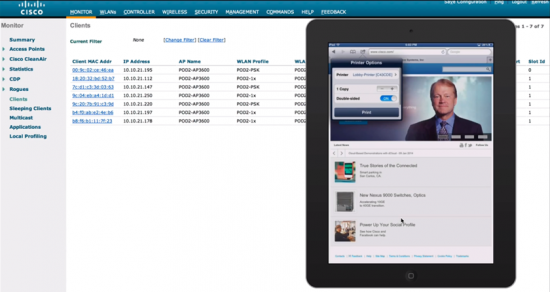This fall your wireless networks will wits many devices upgrading to the new Android 5.0(L-release) and Apple iOS 8 releases (cue: IT managers groan). There have now been many blogs attempting to capture the enhancements expected with these releases. Today I am going to focus on describing how Android L and iOS 8 may stupefy customers deploying Cisco enterprise grade Wi-Fi networks based upon our research and testing of the World seed. Our verdict: Carry on with merchantry as usual.
Here are four features we predict will have the most impact your networks:
1. Chromecast and Google Tint Enhancements (Android L)
Rishi Chandra, the Director of Chromecast Product Management spoken that, starting with the Android L release, users have the worthiness to tint to your neighboring devices such as a TV without having to connect to your Wi-Fi network. In the demo, a phone used the cellular connection to connect to chromecast through the cloud. A variety of techniques are used to demonstrate the users in the same room OR use a pin-code as an alternative. Users can Google Tint an ecosystem of applications or plane their own applications over any Android or iOS device as well as Deject based apps on Chrome.
Predicted Impact: Given that this full-length works transparently to the Wi-Fi, it is expected that there is no impact on the WLAN in your classrooms or dorm rooms or auditoriums where this will most likely be used.
2. Peer-to-peer AirPlay discovery and playback (iOS 8)
Starting with the iOS 7.1 release, AirPlay devices will discover an AppleTV via the bluetooth network. Users could moreover secure their AppleTV via a 4 digit pin-code. With the iOS 8 release, Airplay devices can moreover mirror their content via Airdrop. This full-length offers an volitional method for customers to discover and mirroring of Bonjour traffic without accessing the corporate Wi-Fi network.
Predicted Impact: Again this full-length operates transparent to the Wi-Fi and therefore customers using this full-length should not see any impact on the WLAN. Cisco wireless customers moreover have the worthiness to use the Service Discovery Gateway on Cisco IOS based switches, routers or wireless LAN controllers or the Bonjour Services Directory on AireOS controllers. Customers that use those gateways can disable the discovery of iOS8 using Bluetooth and mirroring via Airdrop. Cisco AireOS and IOS mDNS solutions offer customers the worthiness to discover geographically sparse Bonjour Services e.g. print to the printer in my office from flipside location and set user-based wangle policies instead of relying on a shared pin-code.

3. Randomized MAC Address (iOS 8)
Devices with iOS 8 use a randomized MAC write in probes instead of the burnt in MAC Write in specimen of clients that are not authenticated or asleep. If the phone is awake or associated to Wi-Fi, it will use the real MAC.
Predicted Impact: For customers using Cisco MSE for engaging authenticated clients, for locating rogues, or locating interference, it is merchantry as usual. The value of analytics is volume movement patterns in physical space, so the randomization of MAC addresses in World devices will not impact directional metrics such as user density trends or typical vendee movement paths. For increasingly on the impact of iOS 8 randomizing MAC addresses on Cisco and Cisco Meraki networks, read:
- Apple iOS 8 and MAC Randomization: What It Means for Cisco’s CMX Solution
- Apple iOS 8 and Cisco Meraki CMX
4. Wi-Fi Calling (iOS 8)
This full-length when enabled by the Service Provider allows users that are near a Wi-Fi network to send their voice and messaging over the Wi-Fi network instead of cellular. In areas with cellular coverage holes this will help customers to run calls over Wi-Fi.
Predicted Impact: This full-length was once misogynist in several Android phones. Cisco’s robust Voice over WLAN solution has been once embraced by several mission-critical deployments. In wing there are several enterprise weightier practices and standards introduced including 802.11r the fast transition secure authentication, 802.11k neighbor list radio management and optimized QOS.
Bottom Line
As you can see, the deployment of Android L or iOS 8 releases are not expected to impact your Cisco WLAN deployments this fall (based upon the announcements and limited testing). The upcoming AireOS 8.0 release moreover supports features that enhance mobile shower life including Proxy ARP, Directed Multicast Service and BSS Max Idle.
The upcoming Cisco AireOS 8.0 moreover delivers a comprehensive HDX Optimized Roaming solution for customers with a mix of clients by constantly monitoring the health of the clients and making decisions on urgently disconnecting clients when they move to an zone of low coverage. Cisco HDX Optimized roaming allows clients to roam increasingly intelligently and cleanly between multiple Wi-Fi wangle points as well as between licensed and unlicensed cells.
As iOS 8 and Android L is rolled out, your network will show a significant spike as your devices upgrade their operating system as well as the associated applications. You can use Cisco AVC to manage the impact on networks–see how here.
